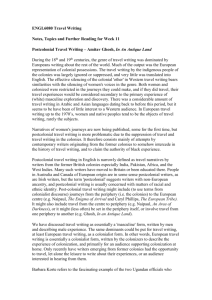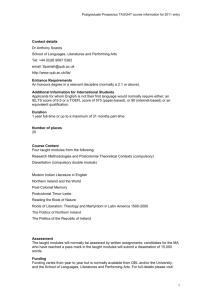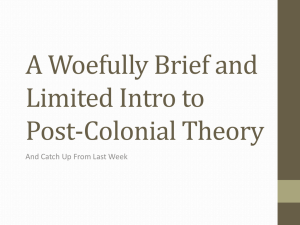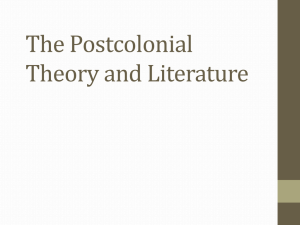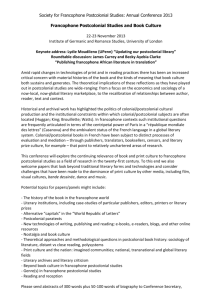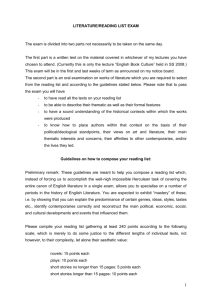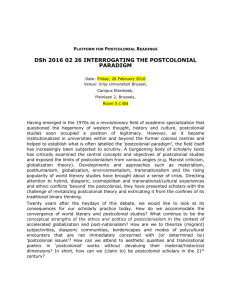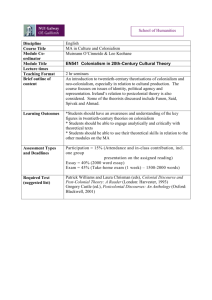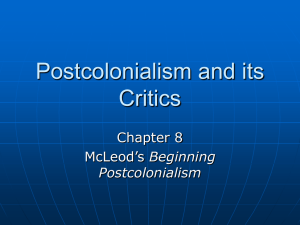Approaches to Teaching Cross-cultural Identity in English Literature
advertisement
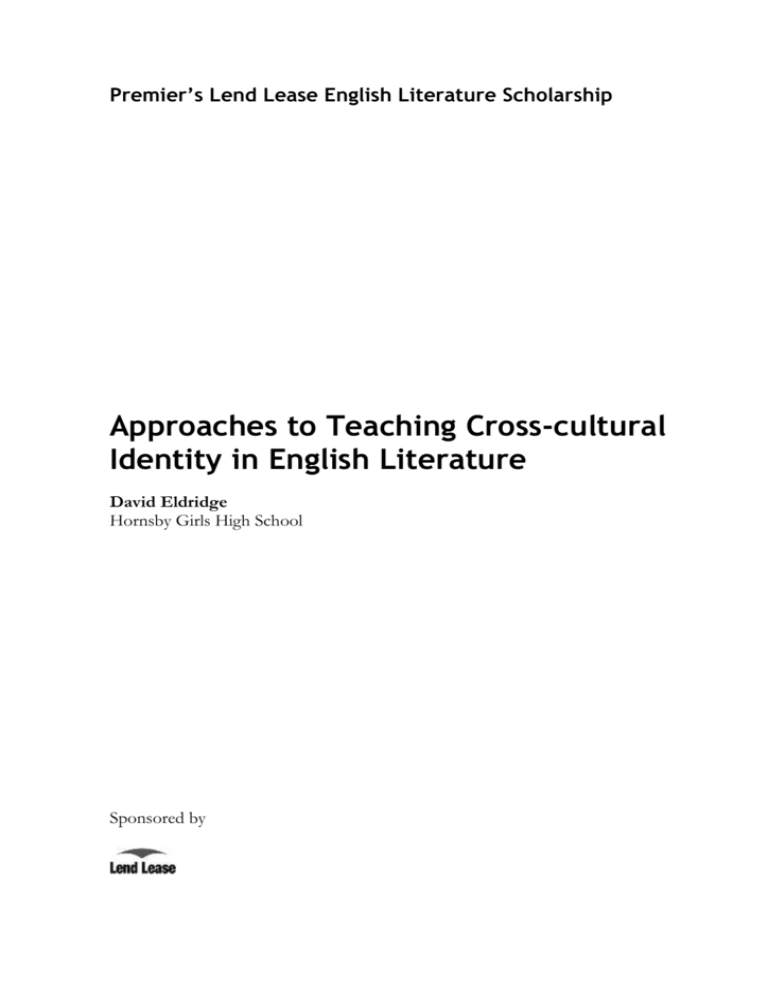
Premier’s Lend Lease English Literature Scholarship Approaches to Teaching Cross-cultural Identity in English Literature David Eldridge Hornsby Girls High School Sponsored by Focus of the Study Developments in the “new” ways of reading, which underpin the rationale of the Stage 6 English Syllabus, require students to have knowledge of how meaning is made, by both the writer and the reader. Thus an understanding of context and culture in literature as well as knowledge of various literary theories that have influenced ways of reading and interpreting texts are an essential part of the contemporary English teacher’s repertoire. The NSW Department of Education and Training and the English Teachers Association of NSW have provided extensive professional development for English teachers. However, as in most workplaces, knowledge, understanding and skills are refined “on the job”. The evolution of my knowledge and understanding occurred through a series of realizations, each of which reflects a conjunction between the syllabus requirements and the realities of my classroom. Firstly, in my multicultural classroom, the word “culture” has associations with language, ethnicity, religion, nationality as well as displacement, re-location and hybridisation. Furthermore, the word is a marker for violent conflicts throughout the world. The political dimension of culture cannot be overstated; culture has always been the tool of the powerful. How often haven’t we heard the mantra: “this is the Australian way”? Having grown up in South Africa I am only too familiar with the discourse of institutionalised racism. Secondly, the Preliminary Extension 1 course and the HSC Extension 1 course directed me to ensure that my students explore ideas of value and consider how cultural values and systems of valuation arise. Implicit here are the dual modes of culture as production and culture as consumption. Thirdly, the HSC Extension 1 Elective: Retreat from the Global prescribes postcolonial texts dealing with characters who are culturally marginalized. There is obvious resonance here. Fourthly, I noticed students increasingly using the new HSC English Extension 2 course to write short stories about the migrant experience. Typically these are based upon personal or family histories. Initially, I found myself teaching culture as locale specific, that is, culture as inextricably linked to territory and manifesting in language, practices, beliefs and artefacts. However, I was also teaching that values are only an expression of the collective experiences of particular cultural congregations and therefore relative as constructions or inventions they can be deconstructed and reinvented in different geospatial contexts. The dilemma I was faced with was that the evaluation of cultural values must be based on some universal criteria. The corollary of saying that “our values are good” is that “your values are bad”. This approach is to disavow tolerance and has the potential to plunge us into a paralyzing cultural relativism. Teaching literature in these extension courses then required that I eschew reductionist definitions of culture. In a world that is struggling to negotiate rapid change and its concomitant strangeness, to represent the discussion of culture, context and values as a contest between fundamentalism and cosmopolitanism seems to deny the complexities inherent in the struggle between local realities and global imperatives, between regionalism and internationalism. This debate is one of the powerful metathemes of postcolonial fiction.i Indo-Anglian writers, in particular diasporic Indo-Anglian writers, have produced a body of English literature that is being widely acclaimed for its exploration of the challenges facing local identities in an increasingly global culture. However, this literature is not without its critics. Many of the best Indo-Anglian writers have been accused of retreating into a metropolitan or cosmopolitan elitism which distorts the authentic voice of the Indian experience. ii Also, I had read that Indians have emerged as the fastest growing group of migrants entering Australia - they are now the third largest immigrant group behind the British and New Zealanders.iii Thus it seemed that the next step in the evolutionary process in the development of my knowledge and understanding regarding cultural negotiations would be to visit the departure points of the Indian diaspora, meet with Indian writers and academics and discuss teaching programs that explore the role of the ex-centric or marginalized character in an increasingly globalised world culture. I was particularly interested in researching the diasporic writers: Anita Desai, Kiran Desai, Bharati Mukherjee, Arundhati Roy, Amitav Ghosh, Gita Mehta, Ruth Prawar Jhabvala, Monica Ali and Jhumpa Lahiri. And, of course, it is ironically the infamous Macaulay’s Minute of 1853iv which led to the Indian civil service having to submit to a study of English literature, that we owe the present study of English. The literature of England was seen as a mould of the English way of life, morals, taste and the English way of doing things. So what was initially conceived of as a means of ‘civilising’ the native population of India is today the basis of our English curriculum. The Research This report is an abridged version of a fuller paper which will be published in the English Teachers Association journal, Metaphor. Having read widely in the area of postcolonial studies and having translated my knowledge into a high school English teacher’s discourse, I assumed I had a reasonable command of the issues and that the study tour would confirm this understanding and offer some new perspectives. I soon discovered postcolonial critics are resistant to the interpolation of postcolonial literature, and themselves, as mouthpieces for the marginalized. When I identified Rushdie as a postcolonial writer existing “in-betweenworlds”, and whose project it is to bring into representation marginalized characters and cultures, Professor Harish Trivedi of Delhi University was dismissive of this view. As a representative from the ‘First World’ I almost axiomatically assumed the definitions of ‘postcolonial’ and ‘marginalized’ to employ a narrow understanding of what postcolonial writers do, viz. present revisionist readings of history from marginalized points of view. Upon reflection, I think this is what the professor was getting at were those cultural patterns of thought that have created the western academy’s fetishising of postcolonial literature through the incorporation of postcolonial studies in English courses (such as the one I teach) and the “prizing” of postcolonial literature (in particular The Man Booker Prize) whereby postcolonial literature is judged, valued and made a commodity by western educational institutions and marketing machines. In other words, the perpetuation of a “regime of value” that decides who or what is canonised. It was one of many unconscious assumptions or cultural patterns of thought that I had to “unlearn” during my study tour. Postcolonial criticism is essentially a Eurocentric project attempting to define the imaginings and historical revisions of colonised peoples. Towards the end of my week in Delhi I was re-reading Homi Babha’s The Location of Culture in the Sahitya Akademi Library in Delhi, and came to the realization that I would be better off refocusing on Homi Bhabha’s more embracing definition of postcolonial perspectives. He suggests they ‘…emerge from the colonial testimony of Third World countries and the discourses of ‘minorities’ within the geopolitical divisions of East and West, North and South. They intervene in those ideological discourses of modernity that attempt to give a hegemonic ‘normality’ to the uneven development and the differential, often disadvantaged, histories of nations, races, communities, peoples. They formulate their critical revisions around issues of cultural difference, social authority, and political discrimination in order to reveal the antagonistic and ambivalent moments within the ‘rationalizations’ of modernity’.x This is, I think, exactly what Arundhati Roy seeks to achieve in The God of Small Things. The return of several of the characters, in particular the protagonists, Estha and Rahel, to the site of “cultural difference, social authority, and political discrimination” is a postcolonial revisiting of India’s histories in order to uncover those “ideological discourses of modernity that attempt to give a hegemonic ‘normality’ to the uneven development and the differential, often disadvantaged, histories of nations, races, communities”. Furthermore, researching Amitav Ghosh, who is regarded by the western academy as a ‘postcolonial writer’, has also broadened my understanding of how history is understood by ‘postcolonial writers’ themselves: their engagement with their cultural histories through a ‘narrativisation’ of history is essentially concerned with representation rather that the ‘facticity’ of events. Like many postcolonial writers, Amitav Ghosh endeavours to recuperate the silenced voices of those not represented in the historical record. As a member of the Indian Subaltern Project his fiction is a writing against the colonial belief that history is dominated by the stories of the elite, and in so doing he foregrounds the experiences of the Indian subaltern - those who are subject to the hegemony of the ruling classes. After listening to Amitav Ghosh’s passionate discourse at the Ubud Writers and Readers Festival in 2005, on the need to develop a transcultural communication I was inspired to teach his texts to my Australian students. This research project has given me the opportunity to visit the western coastal states of Goa and Kerala in order to gather information on the historical references in Amitav Ghosh’s historiographic fiction, which is not only concerned with exploring the interstitial nature of cultures from a postcolonial perspective, but perhaps more importantly, providing a pre-colonial perspective. In a meeting with Professor Malashri Lal of Delhi University, we discussed the tendency of postcolonial critics to disregard, or at best, elide pre-colonial histories in their quest to formulate theories of contemporary inheritances. She also suggested that reading the ‘non-canonical’ postcolonial texts often provide the reader with a clearer vision of traditional cultures and the sociological forces that have shaped them. Professor Lal’s advice was reiterated by Dr Fernandes of Goa University, when during a discussion of colonial and postcolonial texts, he revealed his scepticism in identifying Indian postcolonial writers with the so called ‘canon’ of postcolonial writers. Most of these texts, he said, had been written in the period since independence, and particularly since the Partition and Indira Gandhi’s Emergency, and thus a certain “authentic tension” which is found in the literature of writers such as P.K. Narayan, Mulkaraj Anand and Raja Rao has been lost. (He referred to these three writers as “the triumvirate of Indian Literature”.). Keeping this in mind, I think what Ghosh is trying to establish is a writing position that bridges or mediates these two histories: the pre-colonial and the postcolonial. By so doing he illuminates western modernity’s capitalist driven colonial period as just another intersection in a culture’s histories. Ghosh, who has a PhD in social anthropology from Oxford, has attracted the interest of ethnographers such as James Clifford, Renato Resaldo and Clifford Geertz, for his depiction of inter-weaving vi histories through a literary “excavation” of a pre-colonial world and a post-colonial world. vii In In an Antique Land, for example, the complex medieval cultural mixing of Egyptian, Hindu, Muslim and Jewish cultures is explored through a network of trade negotiations across the Indian Ocean, the Arabian Sea and the Persian Gulf and is represented by Ghosh as based upon mutual mercantile interests rather than power and possession. Contrastingly, Ghosh represents the Portuguese colonizations along the Malabar coast (specifically Goa and Kerala) as based upon greed and profit. Ghosh writes, “having long been accustomed to the tradesman’s rules of bargaining and compromise they [the rulers of the Indian Ocean ports] tried time and again to reach a compromise with the Europeans” viii only to discover that the only choice was between resistance and submission. He continues, “unable to compete in the Indian Ocean trade by purely commercial means, the Europeans were bent on taking control of it by aggression, pure and distilled, by unleashing violence on a scale unprecedented on those shores” ix . In this way through re-imagining history, Ghosh poses a challenge to western postcolonial versions of cultural histories as discrete and separate. Geertz, in a review of In an Antique Land, has referred to this mercantile civilization as a “multicultural bazaar” x which is today “divided like the rest of the globe, into singular and separated national States”xi. The economic and technological globalisation processes of the late 20th century and early 21st century are, however, blurring these separations based on nation states and accelerating the formation of a new ‘postmodern multicultural bazaar’ (which could be described as the theoretical assumption underlying this report). By restoring the marginalized or subaltern’s historical representation through the tracing of the slave Bomma’s story, Ghosh is in a postmodern sense challenging the discrete boundaries between fiction, travel writing, anthropology and history, thereby redefining our definitions of what constitutes “History”. This is a clear example of how literature contributes to the debate between history as knowledge and history as representation xii . Literature, like all art, can offer a paradigm of order in the chaos of the past. Michael Ondaatje’s self-reflexive proclamation in his historiographic novel, In the Skin of a Lion, “Only the best art can order the chaotic tumble of events. Only the best can realign chaos to suggest both the chaos and order it will become” xiii is reiterated in Arundhati Roy’s fictive interrogation of history as a way of ordering reality. Both novels can be categorized as postmodern fiction in the way that they urge the reader to reconsider their understanding of “History” and acknowledge the mini narratives, or local histories, that are often elided in the regulatory discourse of the dominant narrative. The thematic imperative in In the Skin of a Lion is to speak oneself into history: the bridge builder, Temelcoff’s exhortation to Alice, the nun, to find a voice, “You must talk” xiv is a recontextualisation of Frantz Fanon’s resistance to racist exploitation, “to speak…means above all to assume a culture, to support the weight of a civilization”. xv It is interesting to note that like the New Zealand postcolonial writer, Keri Hulme, who has a voiceless character in The Bone People, (also prescribed in The Retreat from the Global elective and also an exploration of conflicted identity), Arundhati Roy has a character who either cannot or will not speak. Estha’s silence – a response to his loss of ontological security when banished from his mother – functions as a figure for the experience of dislocation by colonised peoples and the resultant silencing of their ‘voice’. However, in this example from The God of Small Things, Roy makes the salutary point that not every oppression against which the oppressed struggle is a postcolonial legacy: as a post-colonial critic as well as a post-colonial writer Roy’s politics is just as opposed to discrimination by caste and gender as it is to discrimination by race. It is perhaps interesting to reflect here on the tendency, so often seen in the intelligentsia of colonised peoples, to rationalise colonial rule as an agency of liberalisation in colonial histories. Even if not overtly thematisised, this does constitute a cultural crisis in the national imagination and should not be ignored when discussing post-colonial texts. Ondaatje and Roy share the same epigraph (borrowed from John Berger’s novel G) at the beginning of their respective novels: ‘Never again will a single story be told as though it were the only one’, thus alerting the reader to a self-conscious undermining of the novelist’s traditional function of colonising the reader. Meaning is made by the reader of texts, whether they are literary texts or historical texts. By ensuring our students are aware of how meaning is made through different reading positions and different interpretations we can compare and contrast these different readings and try to understand how and why readers choose them. The pedagogic imperative for the English teaching and learning program is for students to realise that how we read is as important as what we read. The inclusion of post-colonial studies in the curricula of the western academy has facilitated this process, and it is precisely this that has made my study tour possible. The more I talk to people and the more I read the more certain I am that cultural identification is the most important variable in the mix of variables that constitute a ‘reading position’. However, given the cultural interaction of our increasingly globalising culture, cultural identification is characterised by a quality of fluidity. Stuart Hall’s contention that, “cultural identities are the points of identification, the unstable points of identification or suture, which are made within the discourses of history and culture. Not an essence but a positioning” xvi helped me to clarify post-colonial writers’ motives. The cultural practices of diasporic communities are not necessarily restricted by loyalties to nation states – indeed they illustrate the fact that cultural practices are NOT tied to a specific place but might be said to “exist within the hybrid spaces opened up by cultural translation”. xvii And as these spaces become increasingly connected in a global web they constitute the new emergent global culture which has, to borrow a phrase from Clifford, “a hybrid authenticity” xviii of its own. Conclusion The debate concerning the cult of authenticity, represented in Rushdie’s Imaginary Homelands, as that between regionalism and cosmopolitanism seems to me to be organically connected to the issues explored in diasporic studies. My research has provided a rubric for the teaching of the Extension courses. Furthermore, my research has “returned” literature to the foreground of the courses. I was beginning to wonder whether I was teaching Cultural Studies and not English Literature. In particular, the literary debate as to whose voice best represents local interests and the cultural dislocation felt by local groups - metropolitan elites or regional writers - has provided a literary context for the exploration of local and global issues in both my Preliminary Extension course and the HSC courses. Contemporary postcolonial writers such as Anita Desai, Kiran Desai, Bharati Mukherjee, Arundhati Roy, Amitav Ghosh, Gita Mehta, Ruth Prawar Jhabvala, Monica Ali and Jhumpa Lahiri each write from the perspective of one who, in the words of Michael Ondaatje “is born in one place and choosing to live elsewhere. Fighting to get back to or away from our homelands all our lives” xix. The relevance for teaching such writers in the multicultural English classroom in NSW is that students are compelled to engage with culture, not from the perspective of aesthetics, but rather as an “uneven, incomplete production of meaning and value, often composed of incommensurable demands and practices, produced in the act of social survival” xx . When students are told that they inhabit a multicultural society xxi, what does this mean to them? Mutually exclusive cultures cohabiting in the same country? The Tamworth fiasco? The Cronulla Riots? The Australian Tennis Open Brawl? Church leaders denigrating other faiths? The Griffiths murder? The Palm Island controversy? Pessimistic views, such as William Routh’s assertion, in An Australian Film Reader, that “not being sure of who you are is practically the dictionary definition of being Australian” xxii need not result in morbid definitions of national identity (apart from the political agendas of self serving politicians). A culture defines itself through the Other, that is, it knows how to recognise itself through its mix of customs, rituals and myths which differentiate it from other cultures. However, cultures often have customs, rituals and myths in common. Notwithstanding the fact that each of us is (an) Other, we surely have enough common affiliations to accept that collectively we participate in the sociopolitical project xxiii that is Australia. A more sanguine view is presented by Homi Bhaba. He believes that it is in the “interstitial passage between fixed identifications” xxiv that questions of “solidarity and community” xxv lead to “political empowerment and the enlargement of the multiculturalist cause”. xxvi In rejecting the notion of an already established cultural position, he suggests social differences are “signs of the emergence of community envisaged as a project - at once a vision and a construction – that takes you ‘beyond’ yourself in order to return, in a spirit of revision and reconstruction, to the political conditions of the present” xxvii . However, in today’s world the question of identity, both individual ethnic identity and national cultural identity is further complicated by the modern processes of globalisation – those scientific, religious, philosophical or economic paradigms which are continually reshaping and reinventing our world and which inform the “political conditions of the present”. Furthermore, gender, race, ethnicity, class and citizenship are all categories of identification which constitute the “political conditions” of the local and are thereby sites of global/local contestation. English syllabuses can provide a context for students to safely explore these issues: it is in the pages of literature that we can engage with, in Homi Bhabha’s words, “those who have suffered the sentence of history – subjugation, domination, diaspora, displacement [and] learn our most enduring lessons for living and thinking” xxviii . The positive implications of teaching postcolonial texts is further supported by Ashcroft, Griffiths and Tiffin who suggest that most postcolonial writing regards the hybridized nature of postcolonial culture as a strength rather than a weakness xxix .Indeed, we can see that in postcolonial Australia, despite the widespread annihilation of indigenous cultures, the waves of migrants over the past two hundred years have produced social practices which form a complex cultural palimpsest which is the envy of the world. This is our national strength. To suggest that there is only one Australian way is an attempt to rewrite history – again. Multiculturalism IS a social fact – in the world, in Australia, in my classroom. My research has, I believe, strengthened my belief in, and commitment to, the role of literature in developing our students’ self-awareness and helping them to negotiate a changing world. Notes i An excellent exposition of the standoff between the “exotic” and the “regional” in postcolonial writing can be found in Vikram Chandra’s article, The Cult of Authenticity, freely available on the web. See http://bostonreview.net/BR25.1/chandra.html ii ibid. iii Australian Welcome for Indian Migrants, http://newsvote.bbc.uk/mpapps/pagetools/print/news.bbc.co.uk/2/hi/asia-pacific/53... iv For an analysis of how English literature was used as a form of control by the British Raj see Viswanathan, Gauri. 1989. Masks of Conquest: Literary Study and British Rule in India . London: Faber & Faber. v Bhabha,, Homi. 2003. The Location of Culture. Bury St Edmunds, Suffolk: Routledge, 171. vi ‘weaving’ is used in Ghosh’s novel The Circle of Reason as a metaphor for the intertwining and interdependence of middle-eastern and south Asian cultures over a seven hundred year period - from the 10thcentury to the 16th Century. vii Comparisons can be drawn between Seamus Heaney’s use of ‘digging’ as a metaphor to excavate occluded Irish Gaelic histories. (This comparison is useful for the Retreat from the Global elective.) viii Ghosh, Amitav.1992. In an Antique Land. New Delhi: Ravi Dayal. 287-8. ibid. Comparisons can be made with the English in India. During the ‘occupancy’ by the East India Company. Race relations were generally harmonious and intermarriage was a normal occurrence. However, after the British Government took control of the company, race relations gradually deteriorated, until 1857 saw the First War of Independence which was followed in 1857 by the appointment of a Viceroy. The British Raj began and continued for the next hundred years. William Dalrymple’s two books, The White Mughals and The Last Mughal provide an illuminating historical reconstruction of this period as well as positing the claim that prior to 1857 religious tolerance was practiced and the 1857 war was a “war of religion” which has a resonance in today’s fundamentalist struggles for supremacy. x Cited by Robert Dixon in ‘Travelling in the West’ in Khair Tabish ed. 2003. Amitav Ghosh. New Delhi: Permanent Black, 26. xi ibid. xii Ghosh’s pre-eminent position in Indian writing has been recognized by his recent inclusion, along with the legendary Indian filmmaker, Satyajit Ray (who incidentally are both from Bengal) into the Class XI Elective English syllabus of the country's biggest secondary board — the Central Board of Secondary Education in India. From 2007, two books by Ghosh have been included in the list of prescribed books, one of which must be taught as the compulsory text in the fiction category. It is also interesting to note that the only Indian films to be included in the board's list of movies are from Ray's trilogy, Pather Panchali, Aparajito and Apur Sansar. The NSW syllabuses, of course have a much larger national content. There are of course those critics who believe the authentic voice of Indian writers is to be found in the Hindu language or regional languages. This debate, which is essentially concerned with the global local nexus, has been referred to elsewhere in this article. Suffice it to say that India is a diglossic society where English is one of the two official languages in each state. (There are more Indian speakers of English than there are English national speakers of English!) xiii Ondaatje, Michael. 1988. In The Skin of a Lion. London: Picador, 146. xiv ibid, 37. xv Fanon, Franz. 1967. Black Skin White Masks. St Albans, Herts: Granada. xvi Hall, Stuart. 1993. “Cultural Identity and Diaspora.” Colonial Discourse and Post-Colonial Theory: A Reader. Ed. Patrick Williams and Laura Chrisman. Hemel Hempstead: Harvester Wheatsheaf; New York: Columbia University Press, 256. xvii Huggan, Graham. 2001. The Post Colonial Exotic. London: Routledge, 26. xviii Clifford, James. 1997. Routes: Travel and Translation in the Late Twentieth Century. Harvard: Harvard University Press, 185. xix Ondaatje, Michael.1992. The English Patient. London: Picador, 176 xx Bhabha, op. cit. 172. xxi Amartya Sen, the Indian Nobel prize winning economist, writing in The New Republic (18/2/2006) constructs an interesting analysis of multiculturism and what he calls ‘plural monoculturalism’. In the article he offers some challenging thoughts on social segregations caused by segmented schooling policies. This article can be viewed at http://www.tnr.com/doc.mhtml?i=20060227&s=sen022706&c=2 xxii Routh, William. An Australian Film Reader. Quoted by Aninda Basu Roy in “Reviewing the Bush Legend: Australian Cinema and Nation Formation” a paper delivered at conference: Globalisation and Postcolonial Writing. Calcutta University 2006. xxiii Homi Bhabba defines ‘project’ as “at once a vision and a construction” (see endnote 60 below) xxiv Bhabha, op. cit. 3. xxv ibid. xxvi ibid. xxvii ibid. xxviii Ibid. 172. xxix Ashcroft B, Griffiths G, Tiffin H ed. 1999. The Post-colonial Studies Reader. London: Routledge, 183. ix
